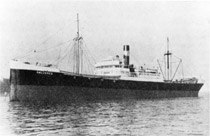 At the start of March 1937, the rebel naval forces were deployed along the whole Biscay coast, blockading the coast, in order to intercept the scheduled arrival of two Basque merchant ships to Republican ports. One was the Mar Cantábrico which was coming from Veracruz (Mexico) with a large weapons cargo. The other was Galdames which was going to leave Bayonne for Bilbao with 173 passengers, three tons of nickel coins casts in Belgium for the Basque Government and general cargo.
At the start of March 1937, the rebel naval forces were deployed along the whole Biscay coast, blockading the coast, in order to intercept the scheduled arrival of two Basque merchant ships to Republican ports. One was the Mar Cantábrico which was coming from Veracruz (Mexico) with a large weapons cargo. The other was Galdames which was going to leave Bayonne for Bilbao with 173 passengers, three tons of nickel coins casts in Belgium for the Basque Government and general cargo.
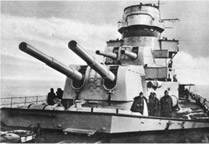 In fact, the Galdames (Captain Hilario Urriz) set sail from Bayonne in the late evening of 4th March. Soon afterwards, it met up with four Basque Navy trawlers that had come out of Bilbao to escort it: the Gipuzkoa (Commander Manuel Galdós), Nabarra (Commander Enrique Moreno), Bizkaya (Commander Alejo Bilbao) and Donostia (Commander Francisco Elortegi). Meanwhile, the cruiser Canarias (Captain Salvador Moreno), the most powerful vessel of the National Navy, in order to prevent either of the two expected merchant ships from entering into port.
In fact, the Galdames (Captain Hilario Urriz) set sail from Bayonne in the late evening of 4th March. Soon afterwards, it met up with four Basque Navy trawlers that had come out of Bilbao to escort it: the Gipuzkoa (Commander Manuel Galdós), Nabarra (Commander Enrique Moreno), Bizkaya (Commander Alejo Bilbao) and Donostia (Commander Francisco Elortegi). Meanwhile, the cruiser Canarias (Captain Salvador Moreno), the most powerful vessel of the National Navy, in order to prevent either of the two expected merchant ships from entering into port.
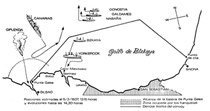 Due to the prevailing bad weather and to the fact that the vessels went with the lights switched off and the radio silent, the Gipuzkoa and the Bizkaya lost contact with the rest of the group. At dawn on the 5th March, when both vessels tried to re-located the convey, they unexpectedly came across the Canarias approximately 20 miles to the north of Bilbao’s harbor. The Canarias only sighted the Gipuzkoa which was coming from Santoña and opened fire against it.. Just few minutes later, a burst of shooting from the Canarias knocked off the bow canon and another caused a fire on the bridge. Five crew members were killed and 12 more were injured. The Gipuzkoa fired back and hit the Canarias killing one member of crew and injuring another (the first casualties of the campaign). Pursuing the Gipuzkoa, the Canarias came within range of the Punta Galea and Punta Lucero coastal batteries, which began to fire to help the trawler. The rebel cruiser changed its course and withdrew to the north. The Gipuzkoa, which was seriously damaged, managed made its way into Portugalete.
Due to the prevailing bad weather and to the fact that the vessels went with the lights switched off and the radio silent, the Gipuzkoa and the Bizkaya lost contact with the rest of the group. At dawn on the 5th March, when both vessels tried to re-located the convey, they unexpectedly came across the Canarias approximately 20 miles to the north of Bilbao’s harbor. The Canarias only sighted the Gipuzkoa which was coming from Santoña and opened fire against it.. Just few minutes later, a burst of shooting from the Canarias knocked off the bow canon and another caused a fire on the bridge. Five crew members were killed and 12 more were injured. The Gipuzkoa fired back and hit the Canarias killing one member of crew and injuring another (the first casualties of the campaign). Pursuing the Gipuzkoa, the Canarias came within range of the Punta Galea and Punta Lucero coastal batteries, which began to fire to help the trawler. The rebel cruiser changed its course and withdrew to the north. The Gipuzkoa, which was seriously damaged, managed made its way into Portugalete.
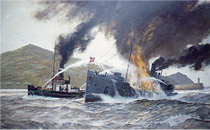 Meanwhile, the Bizkaya had come across a mysterious merchant ship flying the Estonian flag near to Machichaco that had been pursuing the Canarias shortly before the battle. It turned out to be the Yorkbrook which transported weapons for the Republicans. The Bizkaya, taking advantage of the fact that the Canarias was occupied with the Gipuzkoa, immediately escorted it to Bermeo, which meant that the vessel and the weapons were recovered.
Meanwhile, the Bizkaya had come across a mysterious merchant ship flying the Estonian flag near to Machichaco that had been pursuing the Canarias shortly before the battle. It turned out to be the Yorkbrook which transported weapons for the Republicans. The Bizkaya, taking advantage of the fact that the Canarias was occupied with the Gipuzkoa, immediately escorted it to Bermeo, which meant that the vessel and the weapons were recovered.
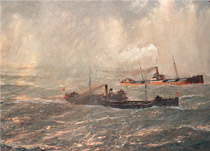 The Pantzeska and Joseba Mikel fishing boats, which were returning from fishing, had now joined the rest of the convoy. Unaware of what had happened, the convoy soon came across the Canarias. It first opened fire against the Galdames, killing five passengers and the merchant ship flew its white flag and stopped its engines. It then fired against the Donostia, which moved away, and finally against the Nabarra. The commander of the Nabarra, despite the fact the odds were against him, decided to open fire on the cruiser and sink fighting rather than surrender his vessel. The Pantzeska and the Joseba Mikel took advantage of this moment to make their way to safety.
The Pantzeska and Joseba Mikel fishing boats, which were returning from fishing, had now joined the rest of the convoy. Unaware of what had happened, the convoy soon came across the Canarias. It first opened fire against the Galdames, killing five passengers and the merchant ship flew its white flag and stopped its engines. It then fired against the Donostia, which moved away, and finally against the Nabarra. The commander of the Nabarra, despite the fact the odds were against him, decided to open fire on the cruiser and sink fighting rather than surrender his vessel. The Pantzeska and the Joseba Mikel took advantage of this moment to make their way to safety.
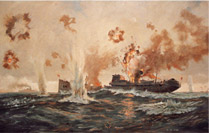 For over an hour and a half, the Nabarra fought with the Canarias, until one of the shells fired by the cruiser hit it directly in the boilers. The Nabarra had no form of propulsion and had to be abandoned. The commander and various other members of the crew preferred to stay on board and go down with the ship. Only 20 of its 49 crew members managed to make the life boats and were later picked up by the Canarias. The Donostia, which had remained on one side due to the lack of range of its artillery, then set course for France. The Canarias then ordered the Galdames to make its way to Pasajes, where a passenger threw himself into the water to try to escape but was shot dead. Days later, on 8th March, the Canarias also seized the Mar Cantábrico.
For over an hour and a half, the Nabarra fought with the Canarias, until one of the shells fired by the cruiser hit it directly in the boilers. The Nabarra had no form of propulsion and had to be abandoned. The commander and various other members of the crew preferred to stay on board and go down with the ship. Only 20 of its 49 crew members managed to make the life boats and were later picked up by the Canarias. The Donostia, which had remained on one side due to the lack of range of its artillery, then set course for France. The Canarias then ordered the Galdames to make its way to Pasajes, where a passenger threw himself into the water to try to escape but was shot dead. Days later, on 8th March, the Canarias also seized the Mar Cantábrico.
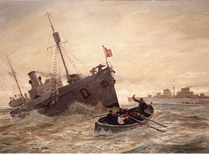 The survivors of the Nabarra, who were taken prisoners by the Canarias, were put on trial several months later and sentenced to death, but the direct intercession to General Franco by the commander and gunnery officer of the Canarias resulted in their being pardoned and released in recognition of their bravery. The crew and passengers of the Galdames were not as lucky and they received long prison sentences and some of them were shot, such as the representative of the Generalitat – the Catalan government in the Basque Country, Manuel Carrasco Formigueira, who was travelling with his family in the merchant ship.
The survivors of the Nabarra, who were taken prisoners by the Canarias, were put on trial several months later and sentenced to death, but the direct intercession to General Franco by the commander and gunnery officer of the Canarias resulted in their being pardoned and released in recognition of their bravery. The crew and passengers of the Galdames were not as lucky and they received long prison sentences and some of them were shot, such as the representative of the Generalitat – the Catalan government in the Basque Country, Manuel Carrasco Formigueira, who was travelling with his family in the merchant ship.
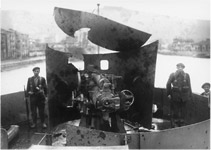 But this military defeat was seen as a moral victory by the population at large. The press did not hide any details of the event, where the fighting by the trawlers against the Canarias was seen as an epic gesture. Acts were organized to honour the death sailors and even the Aberri Eguna of that year was held as in homage to the Basque Navy.
But this military defeat was seen as a moral victory by the population at large. The press did not hide any details of the event, where the fighting by the trawlers against the Canarias was seen as an epic gesture. Acts were organized to honour the death sailors and even the Aberri Eguna of that year was held as in homage to the Basque Navy. 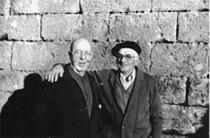 The Basque Navy which, due to its constant activity, had so far achieved the recognition of its efficiency among fishermen and merchant sailors. The population as a whole thus saw it as brave and daring. In memory of the fallen on that day, the Basque Government in exile would decree the "Itsas Gudarien Eguna” in 1978, that is usually held in Bermeo on the first Sunday of March.
The Basque Navy which, due to its constant activity, had so far achieved the recognition of its efficiency among fishermen and merchant sailors. The population as a whole thus saw it as brave and daring. In memory of the fallen on that day, the Basque Government in exile would decree the "Itsas Gudarien Eguna” in 1978, that is usually held in Bermeo on the first Sunday of March.
Documents
Crucero Canarias. ‑ Parte de Campaña nº 18. 12-03-37
Bou Bizkaya. ‑ Parte de Servicios de los días 4 y 5 de marzo. 08-03-37.
